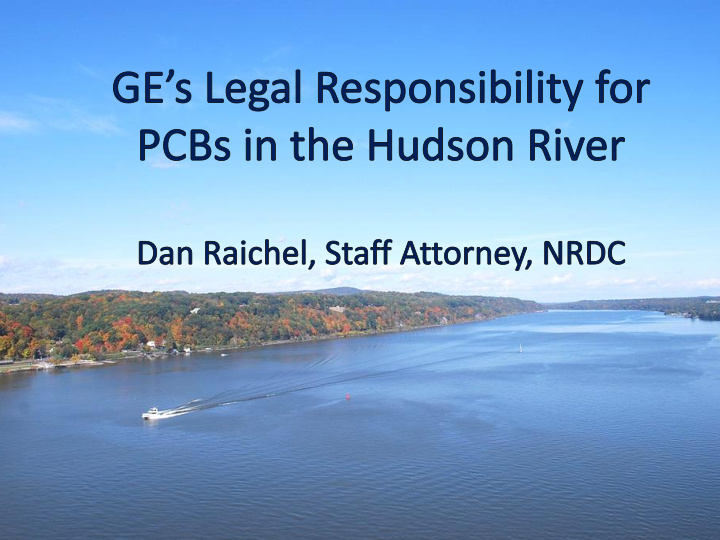



What is CERCLA? • Comprehensive Environmental Response, Compensation, and Liability Act • Very Simple: – You mess it up, you clean it up – Or better yet: you mess it up, you clean it up AND pay compensation for the damage done
CERCLA or “Superfund” Liability 1. All costs of removal or remedial action – Degree of cleanup which “assures protection of human health and the environment” 2. Damages for injury to, destruction of, or loss of natural resources. – Natural Resources Damages or “NRD.”
Who Is Responsible for What? • GE is financially responsible for everything. • Oversight: – Removal or Remedial Action: – Natural Resource Damages: The “Trustees”
Components of NRD • Restoration Costs – returning resource to “baseline” conditions, i.e., the conditions that would have existed without the disposal of toxic waste – Except where “ grossly disproportionate ” • Interim Loss – lost value of services from the resource to the public from the onset of the contamination until the resource returns to baseline conditions • Reasonable costs of preparing the NRD assessment
Injury Determinations • Fishery Resources – PCB levels in fish exceed FDA limits for more than 30 years • Surface Water – Loss of Navigation • Groundwater – In Hudson Falls, Stillwater, Fort Edward • Injury to Wildlife
Problems with the Current Remedy? • “Recovery of the Upper and Lower Hudson River will be delayed longer than anticipated in the 2002 ROD due to elevated PCBs remaining in the surface sediment — equivalent to a series of Superfund- caliber sites being left behind.” • “[C] oncentration [of PCBs] in the surface of River Sections 2 and 3 will be five times higher after remediation than predicted by the 2002 remedy“ • “The magnitude of contamination remaining post - dredging likely will make” restoration of resources most impacted “infeasible.” • “Restoration of the Hudson could be significantly accelerated through additional remediation,” (such as dredging). Failure to do so “will eliminate significant opportunities for restoration of natural resources in precisely those locations where it would be most valuable.”
Addressing Leftover PCBs • EPA – Can review the remedy to see whether remains protective of human health and the environment – 5-year review OR policy review • Trustees – The cost of “restoration dredging” counted toward GE’s NRD liability • GE – Cooperate to achieve truly comprehensive cleanup
Will Restoration Dredging Reduce GE’s NRD Liability? • GE: “there is no basis to conclude that expanded dredging would reduce the Company’s long -term NRD liability.” • The Trustees respond: – “demonstrably inaccurate” – “We continue to assert that additional dredging would reduce natural resource injuries, and associated damages” – Damages will continue into future despite remedy. – Better cleanup now, less liability later.
Simplifying Things • Three options: (1) GE pays; (2) taxpayers pay; or (3) the PCBs stay in the river
Recommend
More recommend